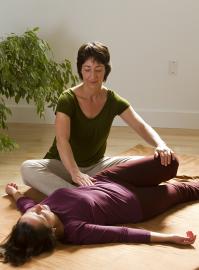
If we look into the meaning of the word “health,” we see that the root relates to wholeness. But how often do we experience a sense of wholeness? Our minds are usually in conflict with our feelings and our bodies, so we want one thing one minute and something else the next.
We need a way to come out of the past and future, into the present. The practice of Breema offers us practical tools to move from where we are to a place where our minds, bodies, and feelings can function together in a balanced way. When you are present, your mind is where your body is. But if you look, you’ll almost always find that your mind is everywhere but with the body.
To become present, Breema asks the wandering mind to instead do a simple job: be with the activity of the body. If we put this into practice, we may find it harder than expected. For example, we may be able to briefly bring the mind to be with the movement of each foot stepping alternately as we walk, but the next time we look, the mind is in the future, thinking about what to buy at the grocery store.
Our bodies are always breathing, even when we don’t know it. And because we can know this—not conceptually, but actually—it’s one of the best ways to practice body-mind connection. So we ask our minds to simply be with the process of inhalation and exhalation. We follow one inhalation until it’s complete, then one exhalation until it’s complete. Don’t change the breath, just be with it, however it is. And if our minds wander and we forget (even after one breath), we will let go of judgment and come back to the next inhalation and exhalation.
This exercise takes us in a useful direction from being complicated toward simply being. The more we can drop expectations and judgment, the more we can be with our activity, moment after moment. It’s not an easy exercise, but when we avoid discouragement and practice bringing together the mind and body, over and over, the mind and body learn to make friends with one another. When the mind and body are friends, the body becomes more relaxed, the mind quiets, and we are more available.
As we continue body-mind connection, a subtle but palpable shift may occur—a new energy and aliveness enters, which signals the participation of our feelings in our activity. The energy of mind, feelings, and body becomes unified. There is a tangible sense of presence. Instead of being passive, we become active participants in life. We experience that we are not separate from our activity, from our surroundings, from others, or from the rest of life. We may see the interconnectedness and interrelatedness of everything and our parts in that. Whatever we are doing begins to feel more meaningful. Once we have a taste of being present, we can start to understand the direction offered by Breema’s Nine Principles of Harmony, and apply the Principles in our lives.
As we begin to be more present, we may experience Single Moment/Single Activity, when activities seems fresh and new, moment after moment, and we get a glimpse of what Full Participation means. There is a natural balance of Firmness and Gentleness in our approach to life. We are more relaxed and feel more at home in our bodies, minds, and feelings—and discover the direction inherent in Body Comfortable.
In the present, thoughts and concerns about the past and future fade into the background. We realize there’s no need to rush or have resistance to what we’re doing, and we experience No Hurry/No Pause and No Extra. We see that everything is exactly as it needs to be and we don’t need to change anything. So we drop ideas of “good” and “bad,” and in an atmosphere of acceptance, move in the direction indicated by No Judgment and No Force. We recognize that we are a part of everything that exists, and that many events have brought us to experience this very moment. We see the Mutual Support in being present.
With the continued practice of body-mind connection, and with application of Breema’s universal principles to our daily lives, we gain the ability to deal with life’s events and conditions and come to balance within ourselves. Our relationships become more harmonious. We now have the tools to move from complication to simplicity, and from fragmentation to meaning, wholeness, and health.
*Where There Is Harmony, There Is Health was written by Elaine Pendergrast and originally published in Natural Awakenings Magazine. Elaine is a Staff Instructor at the Breema Center in Oakland, California.